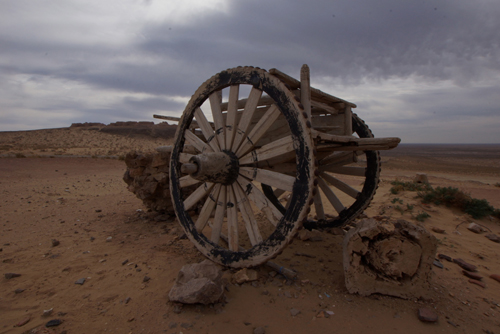Just out of Khiva, on the road to Nukus, there’s a thirty kilometers stretch of trolley bus line that seems oddly out of place within the rural landscape.
Through out most of central Asia we have seen dozens of petrol stations lining our route. Strangely the majority of them are closed and those that are open have long queues of customers. For that reason most of our drivers seemed to run on both gas and petrol.
As we drove through fields of sunflowers, corn and cotton, we were entertained by a local Russian speaking radio station, which was good as our driver had little English and our Uzbek was no better.
Commercial radio, the world over, seems so similar. There’s the machine gun banter of the DJ, that’s interspersed with music, humorous sound grabs and the inevitable ads. This particular station played an ‘easy listening’ combination of local and Western music.
We crossed over the Amudaryo River, a feeder to the dying Aral Sea. Judging by the height of the levy banks this must have been an impressive body of water, however it was barely a trickle now.
The Aral Sea was once one of the largest lakes in the world with an area of 68,000 square kilometers. Constant poaching of water from all of the Aral’s tributaries has left this once massive inland sea all but dry.
It is now only 10% of its original size.
On the way to Nukus we visited three old desert fortresses. Ayaz-Qala, Turpra-Qala and Kyzyl-Qala. There are said to be over fifty in the Khorezm area.
By far the best was Kyzyl-Qala Fortress, the smallest but most compact, that sat on the intersection of two canals and was surrounded by farmland. It was probably the fortified residence of an important Khorezmian aristocrat. The fort was built in the 1st or 2nd centuries AD and was occupied until the 4th century and then abandoned. It was then restored during the 12th or early 13th century, just prior to the Mongol invasion.
After our side trip we were back on the highway to Nukus with desert in either side.
Then, not far from Nukus, a bizarre thing happened. The road turned into four lanes, with drivers using the lanes in either direction, as though each road was Independent.
We reached Nukus mid-afternoon and as we were heading to Turkmenistan early the next morning we made a quick visit to the Nukus Museum of Art.
The Museum was open in 1966 and has the world’s second largest collection of Russian Avant-Garde art. It’s the legacy of Igor Savitsky (1915-1984) who collected thousands of artworks from across the Soviet Union. Much of this art work was banned, or at least disapproved of, by the Soviets. Despite the dangers, Igor managed to spirit them away to this remote gallery.
The Uzbeks and the world are better off for it.
The Uzbek School was by far the most interesting as it featured the Avant-Garde style with a distinctly Central Asian flavour.
The treatment of Mosques, Medressahs, Minarets, bazaars and caravans between 1930 and 1970 was unique.
It was comparable to the vividly exotic eye with which Gauguin viewed Tahiti.










